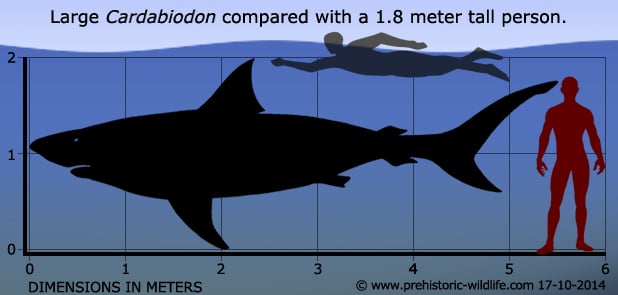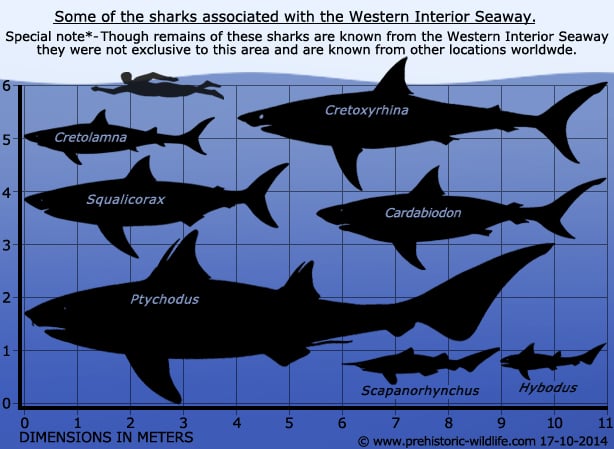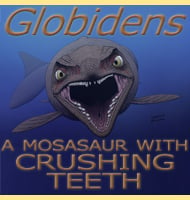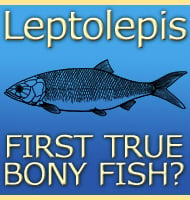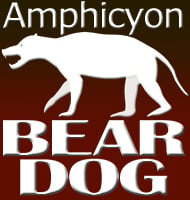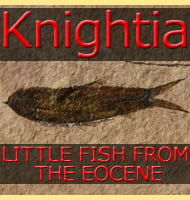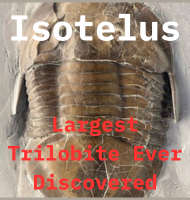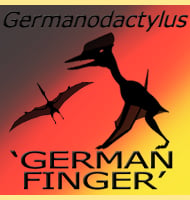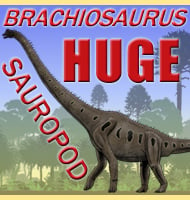In Depth
Cardabiodon is a genus of shark that is known to have lived during at least the Cenomanian and early Turonian periods of the late Cretaceous. First named from fossil teeth and vertebrae discovered in Australia, further examples are known from North America and Russia, as well as speculated in other locations. However, so far Cardabiodon fossils have only been found in fossil deposits that depict what were temperate locations, with a notable absence in tropical waters (for the late Cretaceous period). This would indicate that Cardabiodon preferred cooler waters, though probably not to the extent of the polar cold. Cardabiodon fossils are also known from what were fairly deep ocean floor locations, revealing that Cardabiodon were mostly pelagic (open water) predators.
Large Cardabiodon are generally accepted as ranging between five and five and a half meters long. At the time of the initial description of Cardabiodon as a genus in 1999, Mikael Siverson estimated the total length of the holotype individual to be at least five meters in length. In a 2005 paper by Siverson and Lindgren, the holotype individual was stated as being five hundred and forty centimetres long, by comparing the best preserved vertebrae and comparing it to vertebrae of Carcharodon carcharias (great white shark). In a 2013 paper by Newbrey et al, the upper length of Cardabiodon upon the basis of existing fossils was stated as five and a half meters.
So far Cardabiodon seems to have been comparable to the large modern predatory lamniform sharks that we know today, but still quite a bit smaller than the largest recorded great white shark which was a little over six meters long. The shark that Cardabiodon is most often compared to however Cretoxyrhina, an extinct genus of shark that is also known to have lived in the Cretaceous period at the same time as Cardabiodon. Both of these shark genera are known to have keeled placoid scales which reduced drag when swimming through water, which in turn strongly suggests that both Cardabiodon and Cretoxyrhina were active predators suited for fast swimming. One difference between Cardabiodon and Cretoxyrhina however is that Cretoxyrhina is known from both tropical and temperate deposits, implying that Cretoxyrhina had a greater tolerance to differences in temperature.
Swimming in the late Cretaceous seas, Cardabiodon would have likely encountered many other genera of sharks other than just Cretoxyrhina. However at this time the seas would have also been filled with a multitude of marine reptiles, ranging from plesiosaurs, pliosaurs, marine crocodiles to even early mosasaurs. Some of these may have formed part of the diet for a hungry Cardabiodon, though in turn, Cardabiodon may itself have been occasional prey to some of these predators, such as the large pliosaur Brachauchenius, especially when younger.
Further Reading
- A new large lamniform shark from the uppermost Gearle Siltstone (Cenomanian, Late Cretaceous) of Western Australia. - Transactions of the Royal Society of Edinburgh: Earth Sciences, 90: 49-66. - Mikael Siverson - 1999. - Late Cretaceous sharks Cretoxyrhina and Cardabiodon from Montana, USA. Acta Palaeontologica Polonica 50 (2): 301–314. - Mikael Siverson & Johan Lindren - 2005. - The first record of the large Cretaceous lamniform shark, Cardabiodon ricki, from North America and a new empirical test for its presumed antitropical distribution. - Journal of Vertebrate Paleontology 30 (3): 643–649. - Todd D. Cook, Mark V. H. Wilson & Michael G. Newbrey - 2010. - Vertebral morphology, dentition, age, growth, and ecology of the large lamniform shark Cardabiodon ricki. - Acta palaeontologica Polonica - Michael G. Newbrey, Mikael Siverson, Todd D. Cook, Allison M. Fotheringham & Rebecca L. Sanchez - 2013. – Vertebral Morphology, Dentition, Age, Growth, and Ecology of the Large Lamniform Shark Cardabiodon ricki. – Acta Palaeontologica Polonica. 60 (4): 877–897. – Michael G. Newbrey, Mikael Siverson, Todd D. Cook, Allison M. Fotheringham & Rebecca L. Sanchez – 2015.
